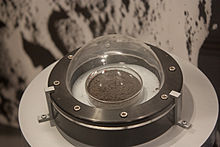
Back تربة قمرية Arabic Ay torpağı Azerbaijani Sòl lunar Catalan Måneregolit Danish Suelo lunar Spanish خاک قمری Persian Sol lunaire French Holdi por Hungarian Tanah Bulan ID Superficie della Luna Italian


Lunar soil is the fine fraction of lunar regolith found on the surface of the Moon and contributes to the Moon's tenuous atmosphere. Lunar soil differs in its origin and properties significantly from terrestrial soil.
As the Moon's fine surface layer, lunar soil is picked up by even weak natural phenomena active at the Moon's surface, allowing it to be part of the Moon's scant atmosphere. It is easily disturbed and poses a significant hazard to exposed equipment and human health. The fine lunar soil is made of sharp and very adhesive particles, with a distinct gunpowder taste and smell. That said, lunar soil is prospected as a lunar resource, particularly for lunar in situ utilization, such as a lunar building material and soil for growing plants on the Moon.
Lunar soil is primarily the result of mechanical weathering. Continual meteoric impacts and bombardment by solar and interstellar charged atomic particles of the lunar surface over billions of years ground the basaltic and anorthositic rock, the regolith of the Moon, into the progressively finer lunar soil. This situation contrasts fundamentally to terrestrial soil formation, mediated by the presence of molecular oxygen (O2), humidity, atmospheric wind, and a robust array of contributing biological processes.
Lunar soil typically refers to only the finer fraction of lunar regolith, which is composed of grains 1 cm in diameter or less, but is often used interchangeably.[1] Lunar dust generally connotes even finer materials than lunar soil. There is no official definition as to what size fraction constitutes "dust"; some place the cutoff at less than 50 μm in diameter, while others put it at less than 10 μm.[citation needed]
- ^ Heiken; Vanniman & French (1991). Lunar Sourcebook. Cambridge University Press. pp. 756. ISBN 978-0-521-33444-0.
© MMXXIII Rich X Search. We shall prevail. All rights reserved. Rich X Search